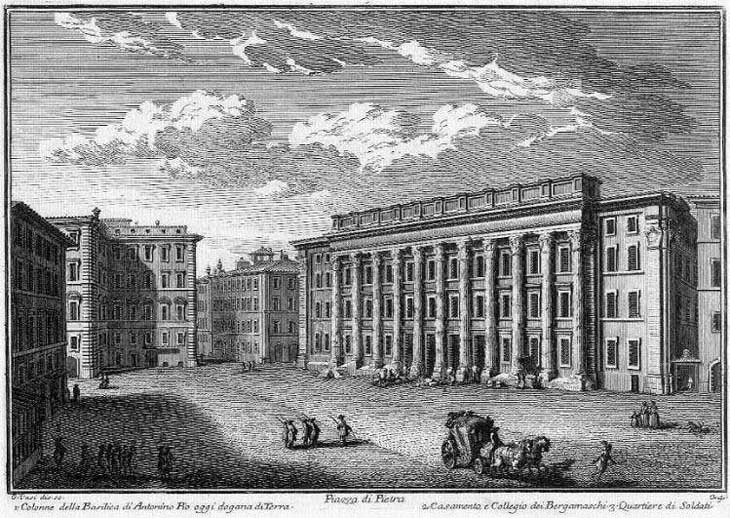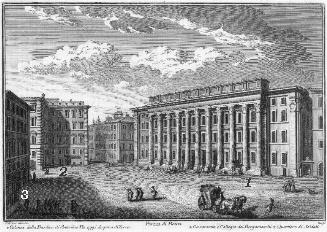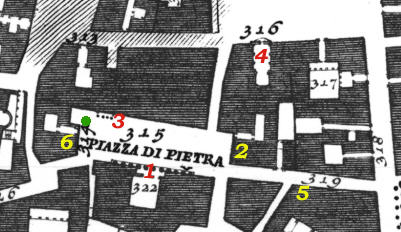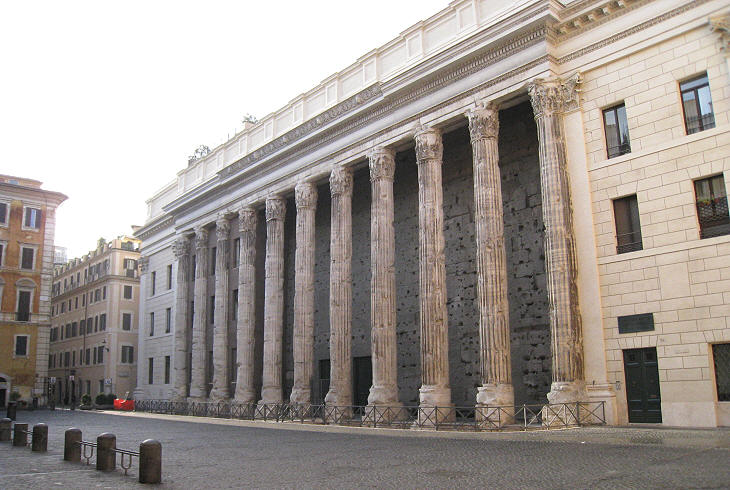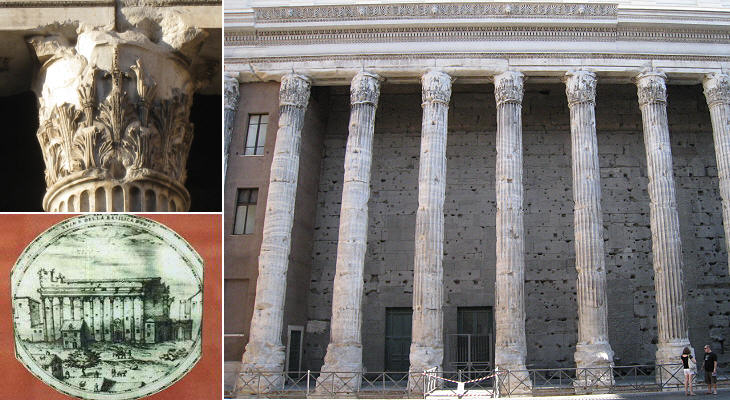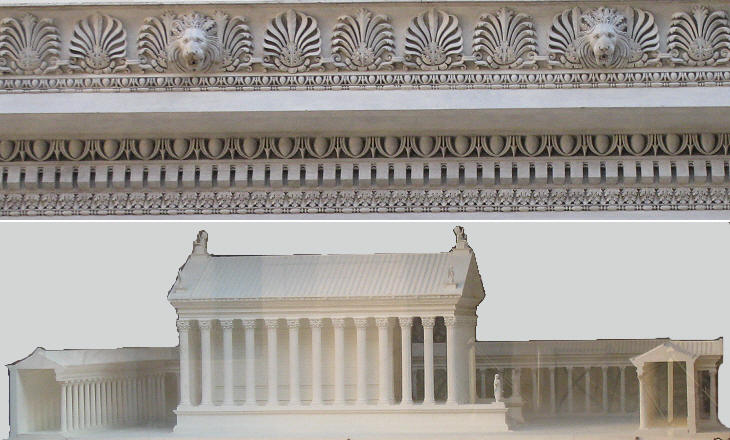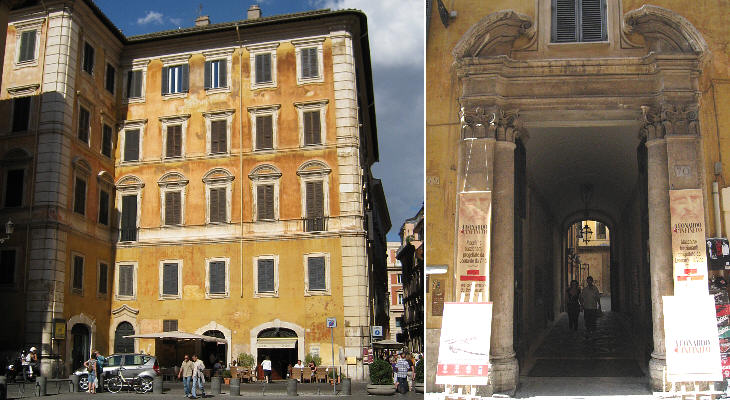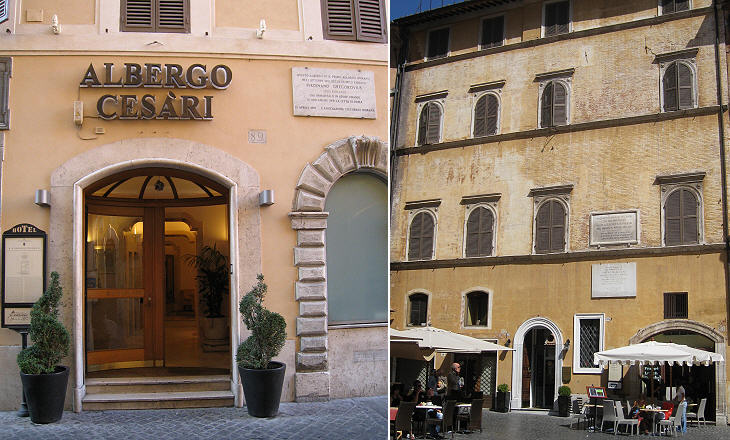  What's New! Detailed Sitemap All images © by Roberto Piperno, owner of the domain. Write to romapip@quipo.it. Text edited by Rosamie Moore. Page revised in October 2009. | Piazza di Pietra (Book 2) (Map B2) (Day 1) (View C7) (Rione Colonna)
In this page:
Piazza di Pietra (stone), the name of the square, refers to the imposing columns of a temple to Emperor Hadrian built in 144 AD by his successor Antoninus Pius. In 1696, during the pontificate of Pope Innocent XII, the surviving part of the temple was incorporated into a large building designed by Carlo Fontana to house the central Customs Office (Dogana di Terra) for goods which reached Rome by land. The view is taken from the green dot in the 1748 map here below. In the description below the plate Vasi made reference to: 1) Colonne della Basilica di Antonino Pio, today Dogana di Terra; 2) Collegio dei Bergamaschi; 3) Quartiere di Soldati (a police station). The map shows also 4) Chiesa dei Bergamaschi; 5) Hotel Cesari; 6) Palazzo Ferrini.
Today
The square is very narrow and the actual view of the temple is not as frontal as in the etching. In 1879-82 the building designed by Carlo Fontana was modified and its baroque decoration was replaced by a simpler one; in 1928 the wall of the cell was freed from later additions and excavations revealed the height of the platform supporting the temple. Hadrianeum
The temple was built on a tall foundation which is now hidden by the higher level of the ground.
An etching of the XVIth century shows how the temple was turned into a fortified house. Today the building belongs to the Roman Chamber of Commerce and the hall inside the ancient cell is used for conferences and small exhibitions.
The temple was surrounded by a portico; the statue of the emperor was placed inside the cell which was decorated with reliefs portraying personifications of the Roman Empire provinces; this perhaps in recognition of the fact that Emperor Hadrian spent most of his life visiting them. Some of these reliefs can be seen in Musei Capitolini. Collegio dei Bergamaschi
In 1729 the brotherhood of the inhabitants of Bergamo (a town near Milan) living in Rome built a large block between Piazza Colonna and Piazza di Pietra. In addition to a church (S. Bartolomeo dei Bergamaschi) the block had a hospice and a college for students from Bergamo. The block had also some flats which were rented and thus granted a substantial income to the brotherhood. Gabriele Valvassori, the architect who designed the flamboyant fašade of Palazzo Pamphilj a Via del Corso, was a member of the brotherhood and he left his mark in the portals, whereas the rest of the building has a simple decoration.
The palace was designed by Onorio Longhi at the beginning of the XVIIth century. The name of the owners, the Ferrini family, is written in the elegant loggia while the inscription over the portal "IOSEPH CINI" refers to Count Giuseppe Cini who owned the palace in the XIXth century.
In the XIXth century foreigners had to leave their passports at the gates of Rome and they were given a special pass. With this document they had to register with the police within 48 hours. Police Headquarters were located at the main Tribunal (i.e. Palazzo di Montecitorio), which is very near Piazza di Pietra. This explains why there were many inns in Rione Colonna. One of them (Albergo Cesari) is located in Via di Pietra and it is still active: it was highly recommended in the Hachette 1853 Guide of Rome for the quality of its water supply (Fontana di Trevi). The plate on the wall commemorates Ferdinand Gregorovius who on October 2, 1852 spent the first night of his 22 years' stay in Rome here. A much older inn (still active) is located in Piazza della Rotonda (not far away). It was quoted in his poems by Ludovico Ariosto who spent two months there in 1513. At the time it was called Locanda del Montone (Ram's Inn), but later on the name was changed into Albergo del Sole (Sole=Sun) (click here to learn more about the historical shops of Rome). The Renaissance part of the building is that on the right where the windows leave an empty space which was painted. Excerpts from Giuseppe Vasi 1761 Itinerary related to this page:
Next plate in Book 2: Piazza della Rotonda Next step in Day 1 itinerary: Chiesa di S. Ignazio Next step in your tour of Rione Colonna: Chiesa di S. Maria Maddalena |
